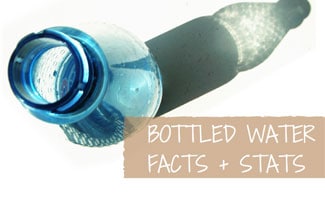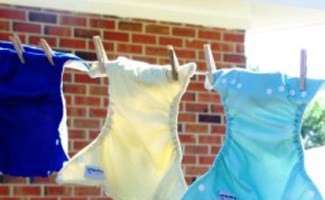Bottled Water Facts & Stats
 Drinking bottled water isn’t only bad for the environment, it’s potentially hazardous for your body too. We’ll take a look at some shocking but important truths about bottled water and the industry that manufactures it. Although the bottles are transparent, bottled water companies are not so much. Let’s save the planet one less bottle at a time!
Drinking bottled water isn’t only bad for the environment, it’s potentially hazardous for your body too. We’ll take a look at some shocking but important truths about bottled water and the industry that manufactures it. Although the bottles are transparent, bottled water companies are not so much. Let’s save the planet one less bottle at a time!
The Statistics on the World’s Water Supply
Some intriguing facts on the world’s water supply:
- Water Aid America states that the daily drinking water requirement per person is between 2 and 4 liters.
- According to Water Aid America, the average North American uses 400 liters of water every day.
- Water Aid America states that 97.5% of the Earth’s water is saltwater. If the world’s entire water supply were placed in one bucket, just one teaspoonful would be potable.
- The World Water Assessment Program (WWAP) breaks the world’s water use down to 70% use for irrigation, 22% for industry and 8% for domestic use.
- The WWAP claims that the six billion people in the world are currently already appropriating 54% of the worlds accessible freshwater from lakes, rivers and underground aquifers.
- The Food and Agriculture Organization of the United Nations and UN-Water state that water use has been growing at more than twice the rate of the population increase over the last 100 years.
- The Global Environment Outlook: environment for development states that water withdrawals are predicted to increase by 50% by 2025 in developing countries and 18% in developed countries.
- The World Business Council for Sustainable Development says that in 60% of European cities with more than 100,000 people, groundwater is being used faster than it can be replenished.
- FAO state that by 2025 some 18,00 million people will live in areas that are experiencing complete water scarcity, and two-thirds of the world’s population will be experiencing stressed water supplies.
- 60 million bottles a day are being tossed into US landfills, where they can take up to 1000 years to biodegrade.
The Environmental Working Group 2010 Study
The Environmental Working Group (EWG) conducted a study on bottled water in 2010. While the year 2010 may seem like a long time ago, it is still a relevant study simply due to the information that this study revealed. The study took a look at a number of factors pertaining to the overall health of bottled water including the actual source of the water, treatment methods used and purity testing. The results of this study were quite amazing and revealed the following information:
- 32% of bottled water brands do not reveal their water treatment methods or their purity testing methods.
- 18% of bottled water brands do not reveal the geographic source of their water.
- 13% of bottled water brands publish water quality testing reports that do not actually contain water testing results. Some of these companies include: Safeway’s Refreshe and Walmart’s Great Value brands.
Even more shocking is the fact that despite having their “faults” pointed out in 2009 by the Environmental Working Group, over 50% of the bottled water brands studied in 2010 shared less information than they did in 2009 or had made no improvements to their poor policies in 2010.
Bottled Water Transparency
As part of their testing the Environmental Working Group ranked bottled water companies in terms of their transparency about their product. From the data obtained in this testing three bottled water companies came out ahead of the competition: Gerber Pure Purified Water, Nestle Pure Life Purified Water and Penta Ultra-Purified Water. These companies ranked above the competition due to the fact that they labeled the location of their water sources, shared their treatment methods and shared purity reports of their product online.
Six companies fared poorly in the Environmental Working Group’s testing however. Perhaps most surprisingly to consumers within this group is Whole Foods’ Italian Still Mineral Water. This particular brand of bottled water failed to provide any of the information that EWG was looking for in their studies.
Additional Findings
In addition to pointing out the best and the worst of bottled water companies in their findings, the Environmental Working Group was also able to reveal a number of other facts about various bottled water companies.
- 11 bottled water companies revealed less about their water in 2010 than in 2009; these companies included Crystal Geyser and Sam’s Choice.
- 29 bottled water brands ignored the new disclosure laws of California and failed to list particular consumer information or did not provide a water quality report when asked to do so by the Environmental Working Group. Included in these companies are: Fiji Natural Artesian Water and Green Planet Pure Handcrafted Water.
- 8 of the 10 best-selling domestic bottled water brands were graded at a D or F level for their level of transparency. Included among these companies are: Coca-Cola’s Dasani, Crystal Geyser and six bottled waters produced by Nestle Waters NA.
- 18% of bottled water labels did not list the geographic source of their water nor did they reveal this information on their website. These brands include Publix, Kroger and Harris Teeter store branded water.
- 32% of bottled water companies provide no information on their water treatment process. These companies include: Giant’s Acadia Natural Spring Water and CVS’ Gold Emblem Natural Spring Water.
Overall Bottled Water Grades
Of the bottled water companies researched by the Environmental Working Group in their study, some of the largest bottled water companies have been graded as follows on a traditional grade scale (A is best; F is worst):
- B – Nestle Pure Life Purified Water
- C – Nestle’s Arrowhead Mountain Spring Water
- D – Pepsi’s Aquafina Purified Drinking Water
- D – Coca-Cola’s Dasani Purified Water
- D – Nestle’s Deer Park Natural Spring Water
- D – Nestle’s Ice Mountain Natural Spring Water
- D – Nestle’s Ozarka Natural Spring Water
- D – Nestle’s Poland Spring Natural Spring Water
- D – Nestle’s Zephyrhills Natural Spring Water
- F – C.G. Roxane’s Crystal Geyser Natural Alpine Spring Water
Has There Been Any Improvement in Bottled Water Labeling?
While the progress in bottled water labeling is bleak, there has been a small degree of progress which tends to get overlooked by the significant lack of change in adherence by the majority of companies. When comparing companies that revealed more information about their water source, treatment and purity in 2010 versus 2009 the results are as follows:
- 38% of companies showed absolutely no progress in better adherence to these regulations.
- 39% of companies showed better adherence to these regulations.
- 8% of companies showed mixed changes in terms of their adherence to regulations.
- 15% of companies showed worse adherence to regulations in 2010 than in 2009.
Is It Only Large Brands That Are Failing?
Is it only the bigger name brands of bottled water that are failing when it comes to revealing pertinent information on their water bottle labels? The answer is no. Both large and small bottled water companies are withholding basic information about their product.
Compliance with the California Labeling Law
Bottled water companies are expected to comply with the newer California labeling law which mandates that any bottled water that is sold in California after January 1, 2009 must have the water source and two methods of contacting the company for water quality reports printed on the label. Unfortunately this study by the Environmental Working Group discovered that many bottled water companies shirk this new law. Of all of the bottled water companies researched, the EWG found that 30.2% of bottled water brands are not complying with this new labeling law. 34.4% of bottled water companies are in compliance and 35.4% are suspected of being out of compliance. (Companies that are suspected of being out of compliance generally do not have expiration dates nor was bottling dates printed on their bottles which may allow them to claim that their water bottled prior to the enacting of the new California law.) What does all of this suggest? Many companies are not hesitating to avoid compliance with state law and in doing so they risk fines as well as negative press. The question is however, just what are these companies so afraid of revealing on their product labels that they are willing to break state laws to hide?
Video: Facts about Bottled Water
This minute and a half video pretty much summarizes some of the harsh truths about drinking bottled water.
So, now that you know the truth, will you continue to drink bottled water?



